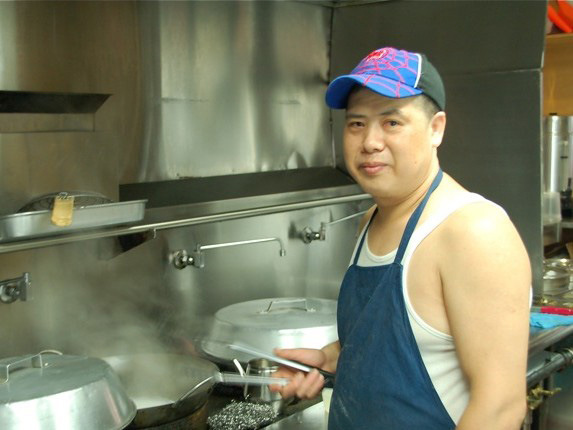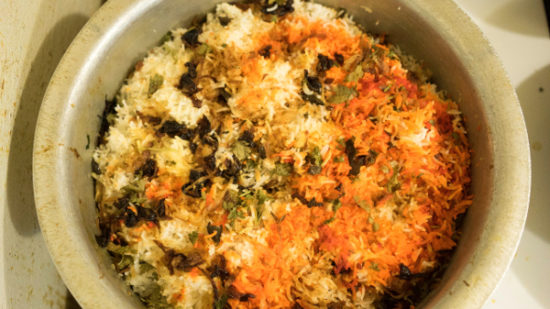Roti is everyday food in Punjabi homes. At the gurdwara, it takes on a new name and becomes a symbol of service.

Sunday morning at the gurdwara, the smell of dough roasting on an open flame is unmistakable. And magnetic. “Pehle pangat, phir sangat,” says Gurmeet Singh. First sit together and eat langar, then pray.
Gurmeet has been running the kitchen at Gurdwara Baba Makhan Shah Lobana in Richmond Hill since it was founded in 1998. Langar, the community kitchen and meal, has been a central part of Sikh practice for hundreds of years. Bustling gurdwaras like this one serve langar around the clock, seven days a week, to anyone who comes, for free.
To make it happen, Gurmeet works in the langar hall from 3:30am until 10:30pm every day, with lots of help from countless volunteers who come do seva (selfless service) in the kitchen one or two days a week, with some coming every day.
Sunday is the busiest day at the gurdwara. About 25 sevadars (volunteers) focus on various tasks to get the day’s langar ready for 1,000 to 1,500 people who funnel in and out of the hall throughout the morning and afternoon.
“Roti is the Punjabi staple food,” says Gurmeet. “We eat it at home too, but when we’re in gurdwara, it becomes parshaada.” Parshaada—the eternal blessing, a gift from our Guru, humbly prepared from the hands of sevadars every day here in Richmond Hill’s, and New York City’s, second largest gurdwara.
Making stacks of parshaaday is the center of the action in the large kitchen. Nineteen sevadars —women, men, girls, and boys — are assigned to this job’s controlled chaos. Atta (duram wheat flour) and water are worked in a massive stand mixer, then the dough is shaped into small balls called perhe (pronounced “peray”). The perhe are rolled out and the disks tossed on the grill, cooked on the flame till they brown and puff up.
Ten-year-old Kushmeet Kaur, in a pink salvar kameez, started doing seva in the langar hall when she was five years old, and parshaada making is her favorite job. “I help make rotis at home too, but I like doing it at gurdwara better because I guess there’s more space here,” she says.
Kushmeet works next to her mom, who hands the flattened disks to the person working the grill. Her older brother distributes parshaaday to those waiting to eat. Making perhe and flattening them is her favorite job, she explains, because “sometimes when you butter [the cooked parshaaday], it burns your hand.”
For 11-year-old Dilbag Singh Khalsa though, it’s all about rubbing a big block of butter on the fresh parshaaday. He says, “Sometimes I can’t make the perhe, so this is like the easiest job for me. I butter the parshaaday and I put them in here,” as he points to a huge 120 quart ice chest full of steaming hot parshaaday.
According to Gurmeet, the kitchen goes through 200 to 300 pounds of atta every Sunday, which makes about 8,000 to 9,000 parshaaday. No one starts eating their dal, saag, or sabji until there is a parshaada, or two or three, in hand.
The same goes for rotis in the Punjabi diet more broadly. If someone wants to know if you’ve eaten dinner yet, they’ll ask, “Have you eaten roti?”
But in the gurdwara, the dedicated hands of dozens of sevadars coming in and out of the kitchen everyday are not just making roti. They’re making parshaada—a blessing for each of the hundreds of people who will eat it. This provides Pupinder Singh, a construction worker who is spending his day off today cooking parshaaday, “man vich shaanti”—peace of mind.
Dilbag sums it up: “It’s not seva unless you have your heart and soul in it.”
RECIPE: Parshaada (Yield 10-14)
Ingredients:
2 cups atta (durum wheat flour, available at South Asian markets)
½ to ¾ cup water
½ teaspoon salt
1 teaspoon oil or ghee (optional)
Procedure:
Combine the atta with salt in a mixing bowl or the bowl of your stand mixer. Add the oil/ghee and stir in the water slowly, ¼ cup at a time, until the mixture becomes dough. Sprinkle in more water as needed.
Knead the dough by hand or with stand mixer for five to seven minutes. Let the dough rest, loosely covered at room temperature, for at least 30 minutes (you can store in the fridge and use the next day too).
Pull off small pieces of dough and form into one- to two-inch balls (perhe) in the palms of your hands. Meanwhile, preheat a cast iron or nonstick skillet on medium-high heat.
Add some dry atta into a small bowl, and coat each perha lightly with atta before rolling out into a five- to six-inch wide disk on a floured (with atta) surface.
Shake excess atta off disk before putting onto the skillet. Cook for one minute, then flip and cook the other side for about a minute and half, until browned and cooked. Flip over once more and press down with spatula or with a towel in your hand until it puffs up, about 10 seconds. This last step can be done directly on a gas burner as well.
Lightly butter the hot roti/parshaada.



